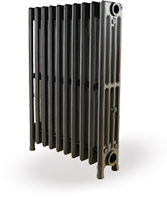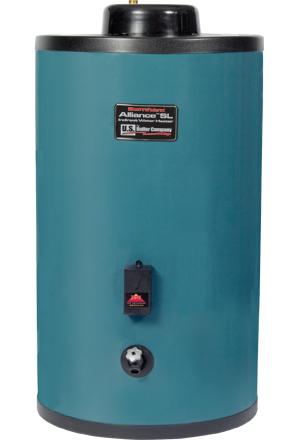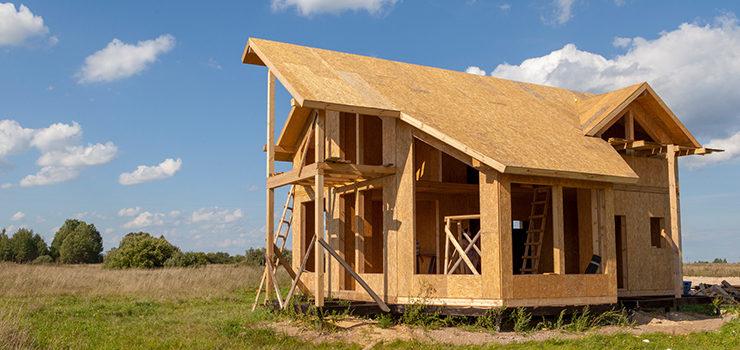In a previous blog, we discussed selecting the correct boiler in a replacement situation. Similarly, how do you select the most efficient heating system for a new home?
There are many heating systems to choose from. The best solution depends on a variety of factors. Fortunately, many of the factors depend on things that you have already taken into consideration while determining the specifics of your new home. For instance: How long will I be in this home? How important is comfort and energy efficiency? Is resale price of this home important to me? What kind of flooring will be used throughout the home? How long and cold are the winters in my area?
Heating System Options
The main heating system options are as follows:
- Electric baseboard
- Geothermal (ground source heat)
- Furnace (forced air)
- Heat pump (forced air)
- Fin tube baseboard (hydronic hot water heat)
- Panel radiators (hydronic hot water heat)
- Radiant in-floor systems (hydronic hot water heat)
Hydronic heating systems use hot water from a boiler to heat your home. These systems are generally considered to be the premium choice and offer the most flexibility in terms of heating options and the ability to connect domestic hot water production into the same system.
If you’re hoping to build a house as inexpensively as possible, or if comfort and efficiency are not high priority, a hydronic system may not be the best option because they tend to have a higher upfront cost while paying dividends later. For all other situations where comfort, efficiency, operating cost, longevity, quiet operation and home value are a consideration, you should discuss the possibility of a hydronic heating system with your builder or professional HVAC contractor. This is especially true where natural gas is available, and in regions with moderate to severe winters.
Let’s dive deeper into the main heating system options.
Electric Baseboard vs. Geothermal – The Two Extremes
Considering costs of installation and monthly expense, electric baseboard and geothermal represent the two extremes of the spectrum. Electric baseboards are inexpensive to install and provide some of the same benefits of hot water baseboard radiators. Where they fall short is in seasonal operational expenses. The monthly cost to heat a home with this kind of heating system in an area with colder winters is exceptionally high. Homes with this kind of heating system also tend to have lower resale values vs. equivalent homes with more conventional systems.
Geothermal heating systems also use electricity to circulate heat, but the monthly cost is very low. This is mainly because they use a small amount of electricity to circulate heat from a constant source that is locked deep in the ground. While this seems like an ideal concept from an environmental and expense standpoint, there are some significant drawbacks. The initial cost of one of these systems is exceptionally high – almost double the cost of a high-end hydronic heating system. While these systems don’t use conventional fuel as a heat source, there are concerns in regard to how “green” they actually are. They require deep drilling in order to access heat underground, and that process can also release greenhouse gases that were otherwise locked in the ground. In addition, these systems cannot be installed everywhere – they depend on having the right geological conditions underground, and local codes that permit deep drilling.
Realities of Forced Air Heating Systems
If you’ve lived in a home with forced air heat, generated by a furnace or a heat pump, you are probably familiar with air movement. Air is drawn from the home through return ducts, heated by the HVAC equipment, and sent back into the living space through supply ductwork.
Even though forced air systems blow warm air into living spaces, they do not completely heat the space. Frequently, cold and/or warmer spots can be detected in homes with forced air heating. Effectively controlling air flow from a furnace to balance the cold/warm spots in a home is very challenging and rather imprecise. In addition, excessive noise from blowers, dampers, and vent outlet plates may be noticeable.
Forced air systems also dry out the indoor air. This is one reason a lot of people struggle with dry skin or chapped lips in the winter. Air movement in the home can also stir up and distribute allergens, dust, dander, and germs. As a result, the overall heating performance of your furnace or heat pump in your newly built home might be suboptimal.
Benefits of Hydronic Hot Water Heat

One of the main advantages of hydronic heating systems is that they do not require the circulation of air within the home. Hydronic systems heat the space via a warm mass, such as a radiator or warm floors. Because of this mass, and the fact that water is a much better conductor of energy than air, cold spots within a home are far less of a factor with a properly designed hydronic system.
Radiators and radiant floor systems heat a space via two means: conduction and radiation. For example, imagine a boiler supplying and circulating hot water through a home’s various radiators. The radiators then warm the air it encounters through conduction. It is conducting energy (heat) to the air. This air, because it’s warmer than the surrounding air, tends to rise.
What about radiation? Radiation warms everything within the space regardless of air. Think about a hot coffee mug. Pick it up and hold it in one hand. Now place your other hand several inches below the mug. Even though the air that’s being heated through conduction is rising, you can still feel heat from the bottom side of the mug. This is radiation at work. Therefore, the radiator warms the air, people, and items in the home through radiation.
What about Air Conditioning?
One main reason that forced air systems are generally considered as a default choice of new constructions stems from the use of air conditioning in summer months. At first glance, it would seem to make sense to have both heating and air conditioning delivered to the interior by the same ducts. It costs less, right?
Yes, it generally cost less to install a typical HVAC air system when building a new home. However, it may end up costing more in the long run. The reason is due to efficiency; warm air rises, and cold air falls.
Typically, before installing a forced air system, a decision is made that a new build is going to favor either heating or air conditioning with the installation of the air vent outlets. They are either in the floor (favoring heat) or in the ceiling (favoring A/C). In all areas with moderate to severe winters, the vents will be in the floor because heat rises. During summer months, the air conditioning system will use the same floor vent outlets to pump cool air into the living space. It will depend on the system fan to get the cool air all the way up to the top of the living spaces to provide comfort. That means long and frequent cycle times, higher cooling bills, and added strain on equipment.
If you want air conditioning to compliment a hydronic heating system, the output vents will be in the ceiling, not the floor. The cool air will be dispersed more evenly and will naturally disperse into the living space because cold air falls. This should lead to shorter cycle times, lower cooling bills, and less strain on equipment.
Types of Hydronic Systems
Below is a summary of primary hydronic systems. There is almost no limit to the size of a hydronic system. In fact, the items below can be mixed and matched within the same home.
- Fin Tube Baseboard
Copper fin-tube radiators (commonly called baseboard radiators, and not to be confused with electric baseboard) are probably the most common application of residential hydronic heat. They’re cost effective, easy to install, and provide the premium comfort that hydronic systems are known for.
- Cast Iron Radiators

When people think of cast iron radiators, most immediately think of the old, standing radiators typical to old homes in the northeast. However, cast iron radiators can also be used in new construction, especially when the owner is looking for a vintage atmosphere. These tried-and-true radiators last almost indefinitely, and pair very well with modern boiler technology.
- Cast Iron Baseboard
Cast iron baseboard is less common than standing cast iron radiators, though just as good. A cast iron baseboard system can be a fantastic choice. It will have a higher upfront cost than fin-tube baseboard, but provide durability and a very stately look.
- Panel Radiators
Panel radiators come in a wide variety of sizes, shapes, and applications. They are typically hung on a wall and look very modern. Panel radiators are often used in Europe. Panel radiators can also serve as coat racks and towel holders depending on the application and desired use.
- In-Floor Radiant

If you desire the most comfortable heating system money can buy, you should consider installing in-floor radiant heat. In-floor heat consists of hydronic tubing installed below the flooring. This can be in a concrete slab, in a track system, or stapled to the underside of the subfloor from below. When properly designed and installed, radiant can work with any floor covering material. Because of the labor involved, in-floor systems are generally one of the more expensive applications of hydronic heat. However, simply imagine walking around in the winter with no socks on and having warm feet!
The Additional Benefit of Domestic Hot Water 
You can easily add-on an indirect-fired water heater to any hydronic heating system. An indirect-fired water heater, also called an indirect tank or sidearm tank, is a water heater that does not have its own stand-alone heating element. These insulated tanks contain a heat exchanger that allows the home’s boiler to provide all the domestic hot water (DHW) needed in a home. DHW is the hot water used for showers, sinks, dishwashers, and washing machines.
The advantages of an indirect tank over a conventional water heater include faster recovery time (speed at which unit produces hot water), lower operating costs, and reduced maintenance.
Choosing a Hydronic Heating System
Hydronic systems are the most comfortable, efficient, and durable heating systems available for new home construction.
U.S. Boiler Company produces boiler models to fit all variety of hydronic applications. Our high-efficiency models, like the Alta, Aspen, Alpine and K2, are great choices anywhere natural gas or propane are available and the highest level of efficiency is desired. Our gas-fired cast iron models also provide major flexibility and durability at a lower price point.
For installations where only fuel oil is available, look no further than the MPO-IQ. Its efficiency, robustness, and ease of maintenance make it arguably the industry’s best oil-fired boiler.
Choosing the heating system in a new home is a major decision. Discuss your options with a professional heating contractor in your area to find the best option for you.

